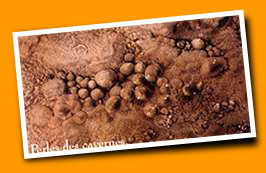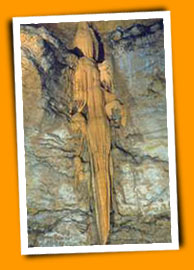

CRYSTAL FORMATIONS
The triangles are in fact the most extraordinary concretions, but there are other, very beautiful and very interesting ones: At approximately forty metres high, in a layer of grey marl, sandwiched between two layers of Maastrichtian limestone blocks, four superb monumental concretions weighing several tonnes each adorn the roof, like diamonds on a crown. These are our fountains that provide glitter. The Medusa, the Mermaid, the waterfall and the octopus, formed by calcite-rich water that drips from four fractures, were formed during the early stages of the cave. Today, the water that drips from these impressive formations transforms pieces of pottery into absolute gems over the course of one year.

Once again, alchemy is on the side of "cave pearls", a tiny grain of sand in a water-filled hole is tossed around by the waves, and around and around it goes. "A rolling stone gathers no moss", or so the saying goes. This is an untruth, I assure you, because that tiny grain of sand is covered with calcite each time it turns, and grows ever so slowly, like a pearl in its oyster.
The draperies: the drop of water slides down the rock, like a drop of rain on a window pane. The second drop follows the first one, the third one also follows the same path. Each drop deposits its calcite on the same path. That is how these superb translucent, sparkling and even musical "draperies" are formed. Delicately, using a small stick or a finger, they can be used to play some melodies!
Stalactites (that hang!) and stalagmites (that rise) are well-known and appreciated concretions. Everyone knows that the drops of water take a good century to form, by falling, just one centimetre of stalactite. In fact, the length and time are based on the volume of water that flows, its calcite content and the ambient temperature.
What occurs when a stalactite and a stalagmite meet halfway? They form a column, of course.
There are some unruly stalactites however, they are known as helictites. Suddenly, without any explanation, they deviate from the straight and narrow path and grow in other directions. Of course, they are still attached to their mother-stalactites, but they find a way to deviate horizontally, go upward, turn, etc. And no one, not even the experts, can provide a clear explanation as to how this happens. Some claim it is due to "wind" or "capillary forces", who knows! In any case, they are beautiful and curious.
The soda straws are very, very thin, and also have a drop of water at the tip that continues to fall. Actually, when examined very closely, we can see that they are hollow, like a tube (or a straw used to drink orangeade in summer!), and that instead of flowing on the outside, like other stalactites, water slowly seeps inside: that is why there is always a drop that swells at the very tip before falling!
There are also those walls that form dams and trap small pools, the "gours"; they are made entirely of calcite and grow gradually as the water fills these small lakes.
In those areas, the water is lively and flows. It flows over the edge of the dams which accumulate the calcite during the process. That is how these walls reach heights ranging from a few centimetres to several metres!
In these active, agitated waters, we can also find rounded concretions that strangely resemble cauliflower heads. Therefore: they are called "cauliflower-like concretions".
And we will finish by once again mentioning the triangles, those famous triangles, which, unlike the cauliflower, can only be found in very shallow and above all very still water.
Calcite can form multiple catalogued structures (several hundred), but the main ones can be admired in the depths of the Gouffre de Proumeyssac.
In these active, agitated waters, we can also find rounded concretions that strangely resemble cauliflower heads. Therefore: they are called "cauliflower-like concretions".
And we will finish by once again mentioning the triangles, those famous triangles, which, unlike the cauliflower, can only be found in very shallow and above all very still water.
Calcite can form multiple catalogued structures (several hundred), but the main ones can be admired in the depths of the Gouffre de Proumeyssac.
